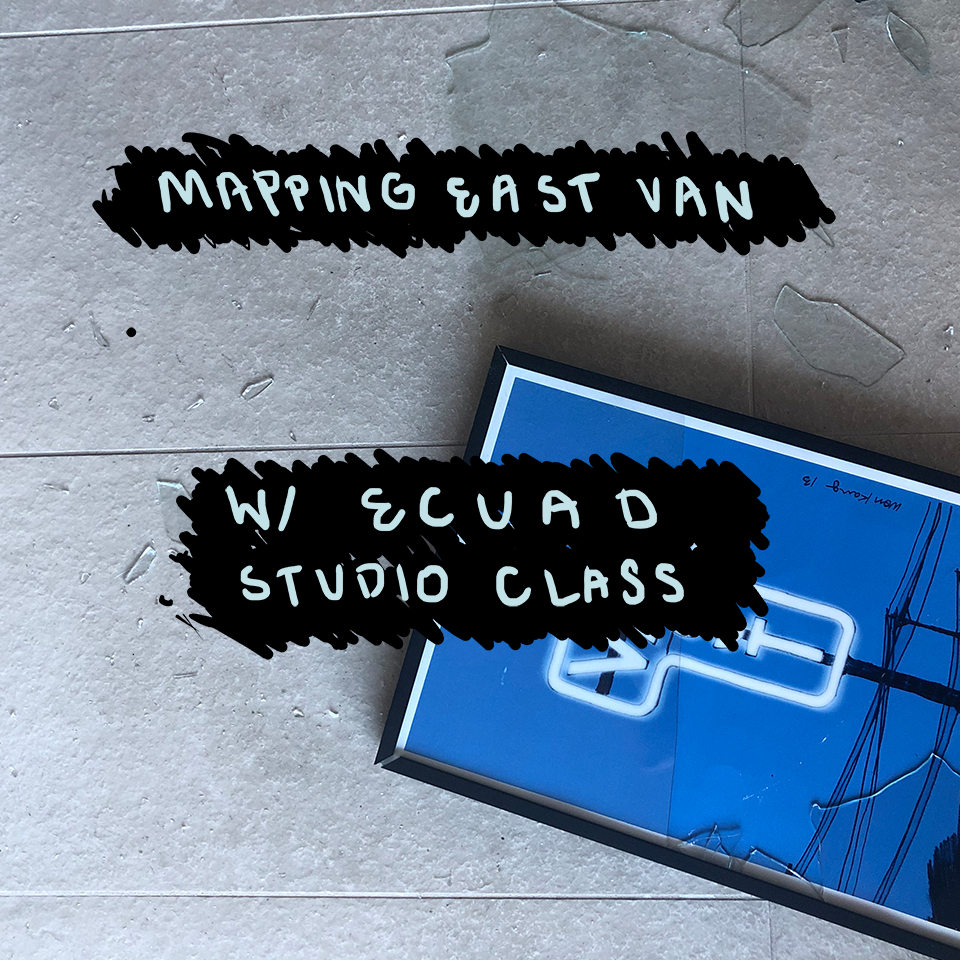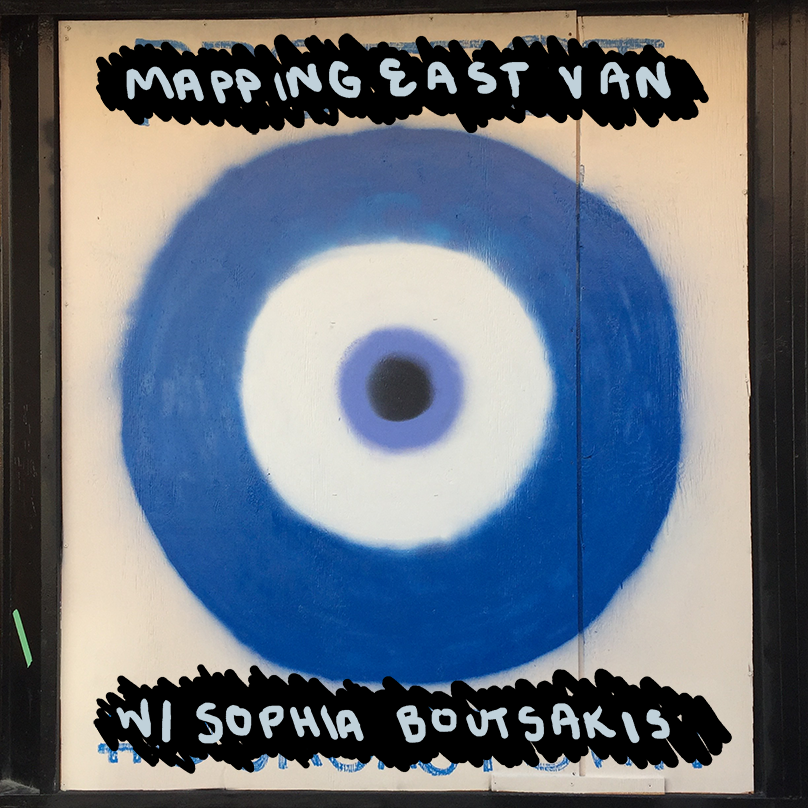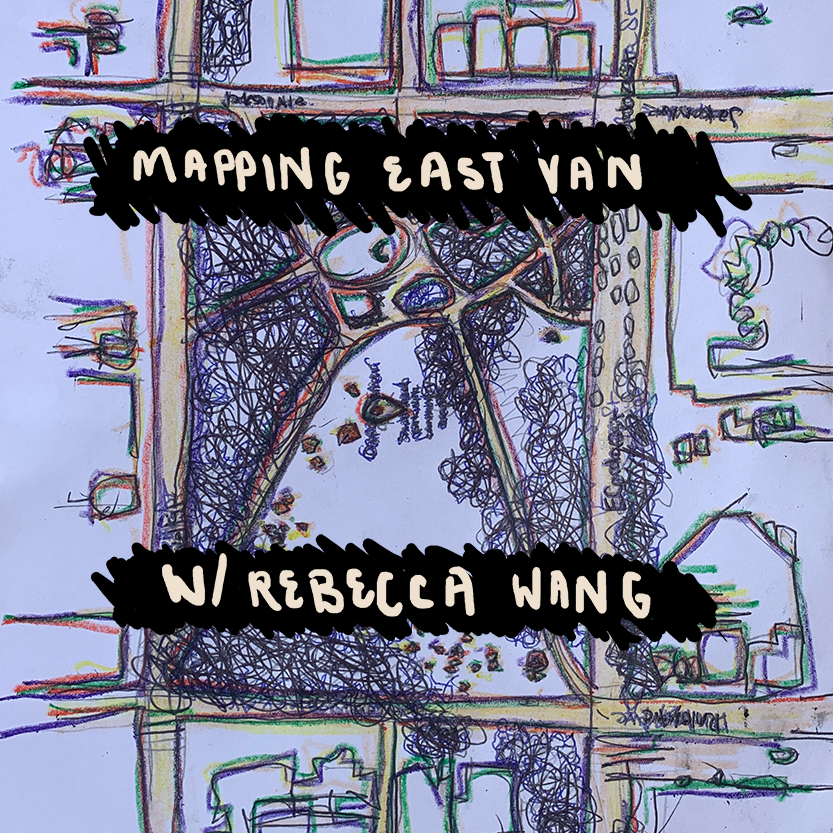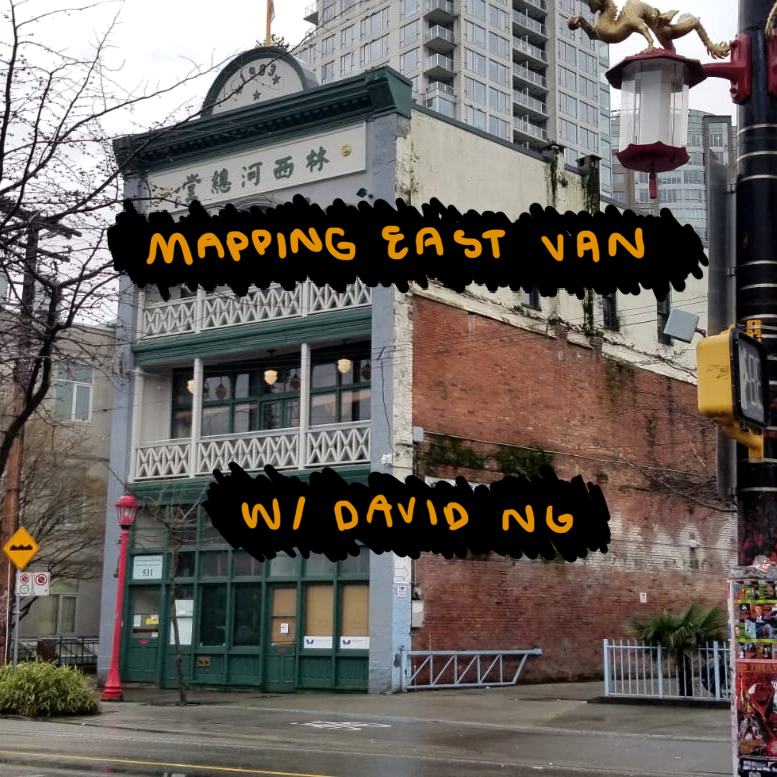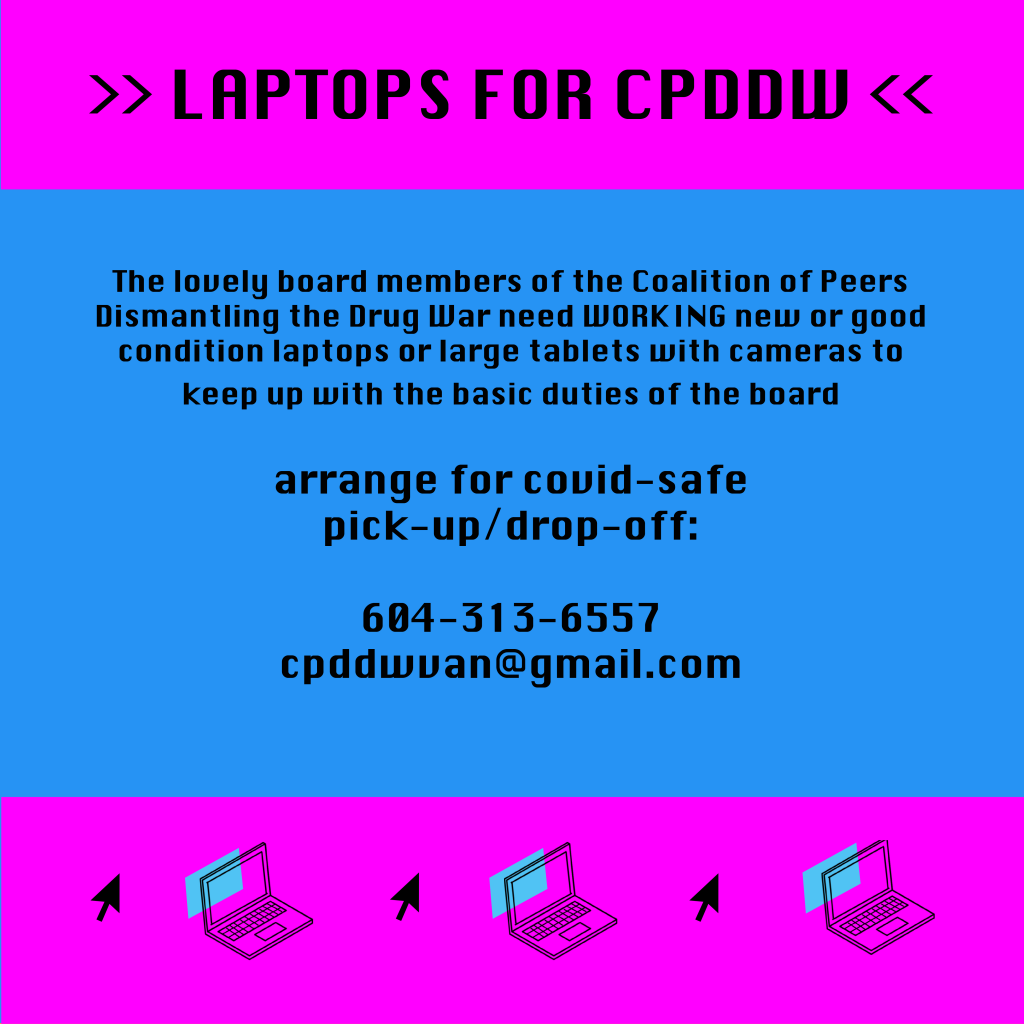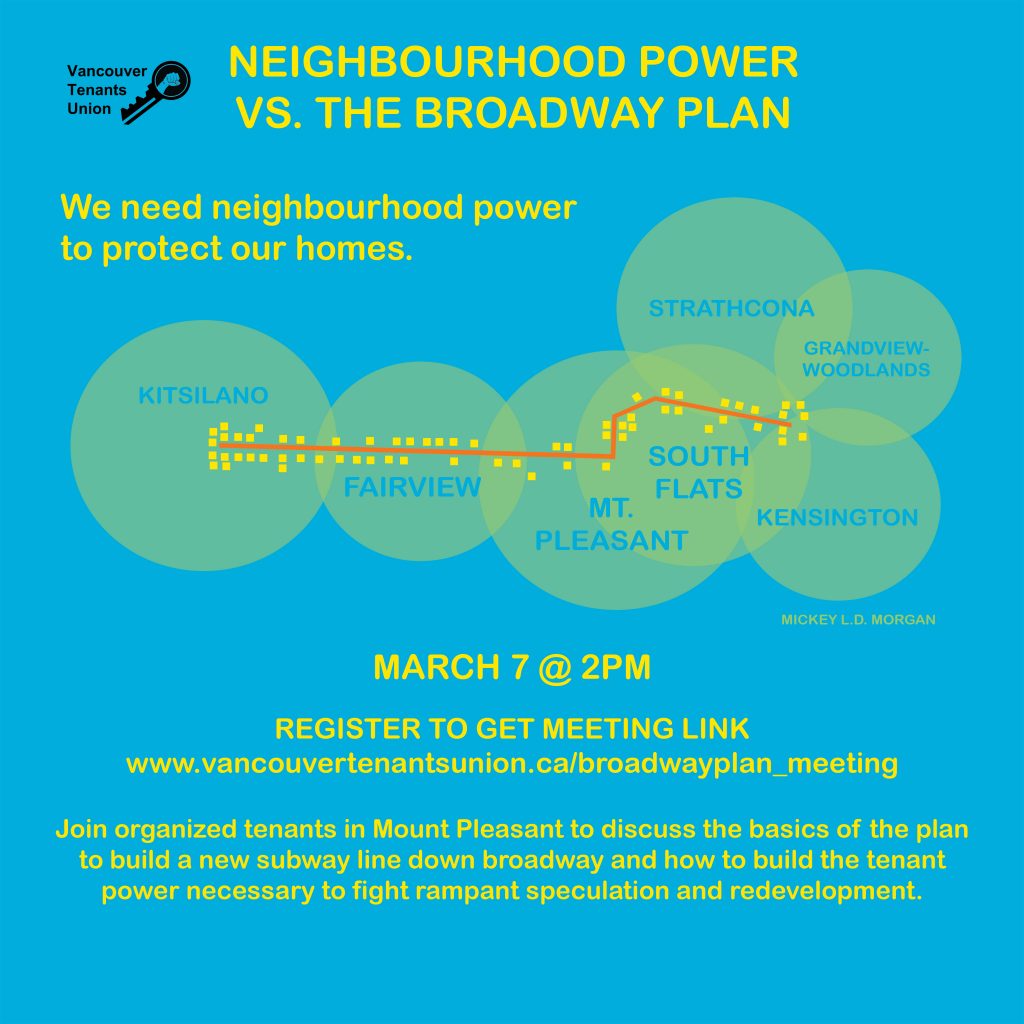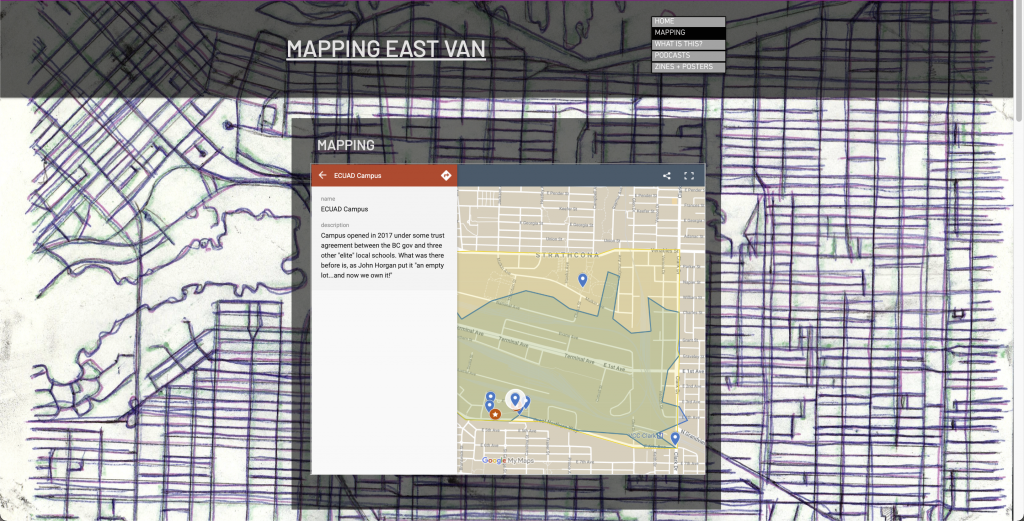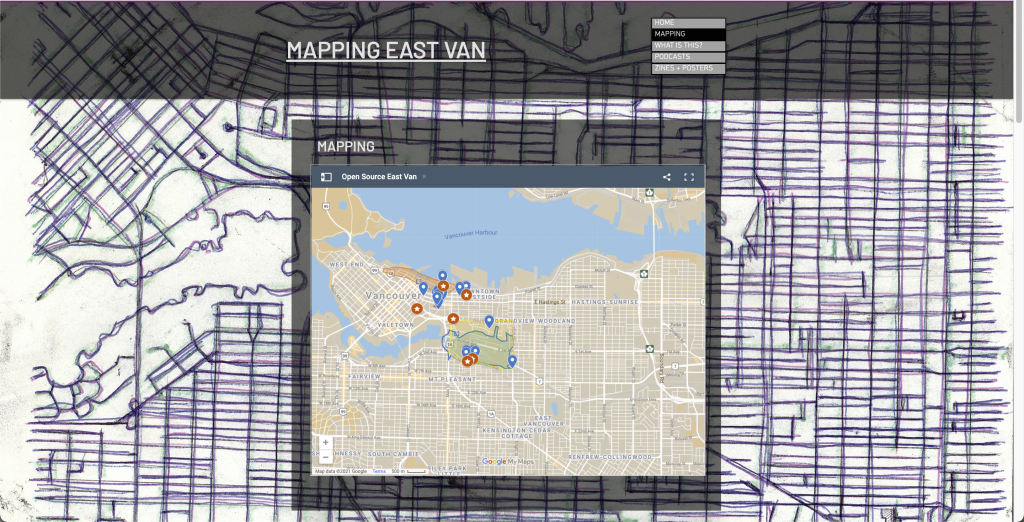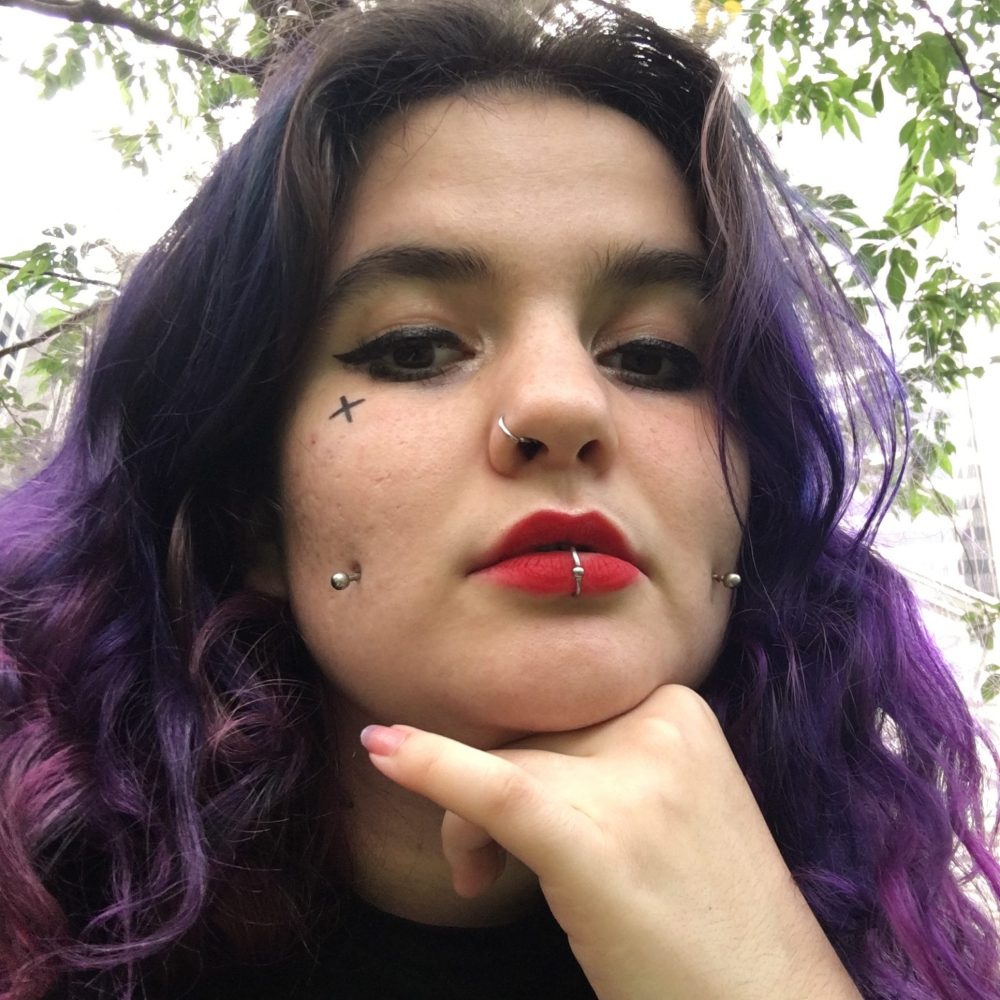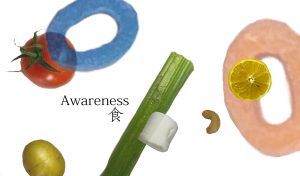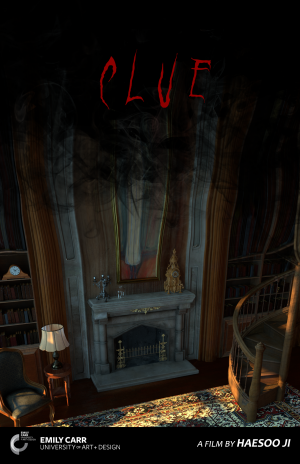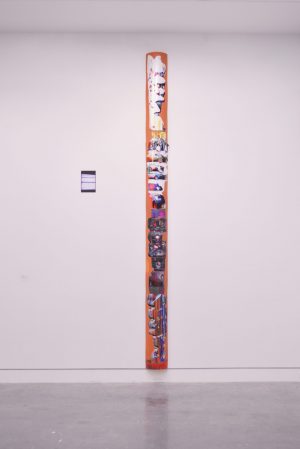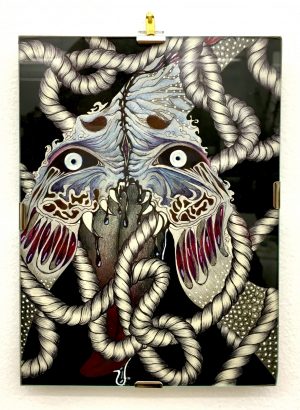- #Accessibility
- #Activism
- #Archival
- #Care
- #Community
- #Connection
- #COVID-19
- #Critical Design
- #Culture
- #Decolonization
- #Digital
- #Drawing
- #Ecology
- #Education
- #Embodied
- #Emotion
- #Environment
- #Event
- #Experimental
- #Healing
- #History
- #Identity
- #Imagination
- #Immigrants
- #Interactive
- #Landscape
- #LGBTQ+
- #Maps
- #Material Practice
- #Mixed Media
- #Multidisciplinary
- #Narrative
- #Nature
- #Participatory
- #Personal
- #Practice-based
- #Printmaking
- #Publication
- #Reflection
- #Relationships
- #Research
- #Series
- #Social
- #Sound
- #Speculative
- #Storytelling
- #Sustainability
- #Transition
- #Urban
- #Visual Development
- #Wellness
Mapping East Van
Mickey L.D. Morgan
This is a map of East Van, and in no way is it objective. No map is. From their legacy in documenting/justifying colonization to a visual aid for developers and city “revitalizers” chopping up the Downtown Eastside and other anchors of East Van into smaller and smaller pieces, maps are collections for stories of violence. So too, can maps hold tales of resistance and hope and those who refuse to keep quiet, those who know that a story told can never die.
I’m Mickey Morgan, I use they/them pronouns, I’m a cartographer and translator and listener and storyteller. This map we’re making is composed of stories shared using various media and is part of a few inter-connected projects like a zine, an open source map, and a podcast, but primarily are ways to understand mapping as storytelling (and vice versa). There are two foundational stories to this map. First, I am a settler, a squatter wherever I am on Turtle Island. Land, Water, and Air which is rightfully stewarded and traditionally known by Indigenous people. East Vancouver is a colonial title and borders for Land of the Sḵwx̱wú7mesh, Səl̓ílwətaʔ/Selilwitulh and xʷməθkʷəy̓əm nations, and where I create this is also Land of the Sto:lo nation. The colonial names, uses, and very shape of the Land as we know it now go hand in hand with the constructs of property, race, gender, disability, class, and all these other things which are made up as justification of violence– as if there could ever be justification for such things. Two, East Van is my home, though I don’t live here and I am unable to physically be here, I owe it to my neighbours to show up. We are responsible to each other, all of us, even you.
The work in it’s original format can be found at this link
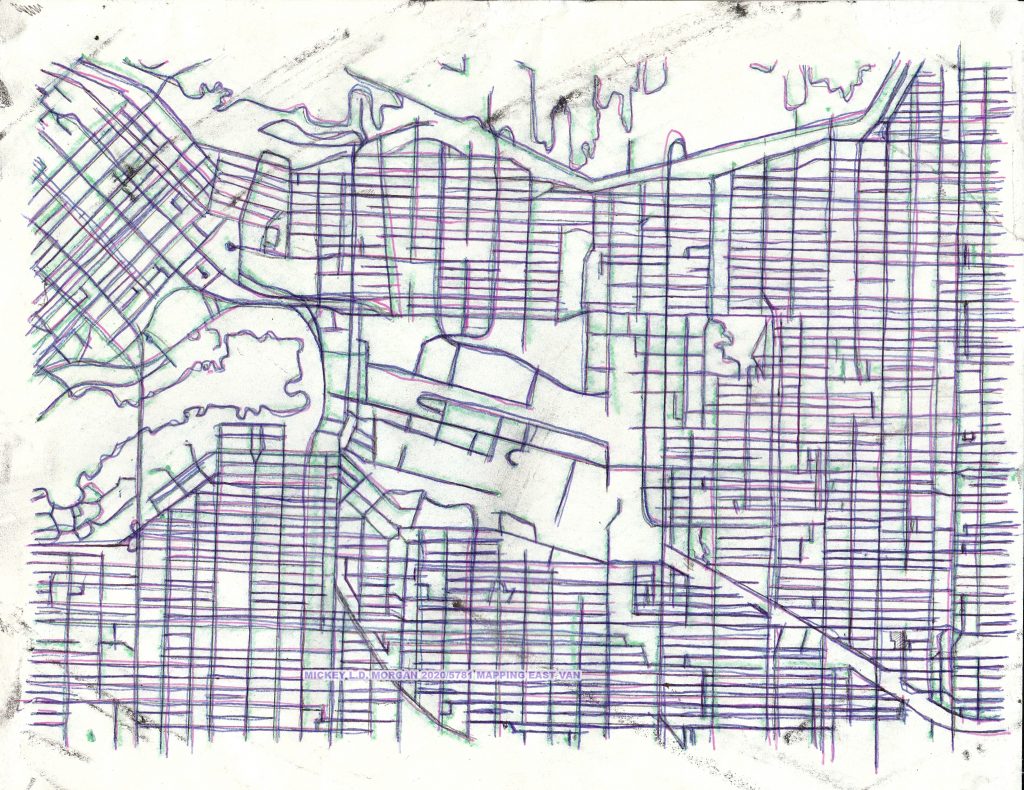
This is East Van
Before anything else, to understand and re-orient myself with the place in a socially-distanced manner with the space I explored it through google maps, current events, memory, and material practice, creating a series of mono-prints with a technique learned from Mark Johnsen’s DIY Printmaking course in Summer 2020. The first iterations were more specific to the Oppenheimer Park area as the tent city was being evicted early into the lockdown. This detailed tracing emerged as a literal physical background to Mapping East Van, marking what colonially fashioned stories I have come to know through tracing over this modern-matrix over and over again, at the same time ruminate on the stories of the Land & Water as it came to be from where I am positioned Here and Now.
One year later we remain in a COVID pandemic during the wake of the third such violence against our houseless neighbours in what is supposed to be public green-space for everyone, the overdose pandemic and housing crisis ongoing while the Vancouver Parks Board, Vancouver City Council, VPD, and other colonial authorities has forcefully evicted our neighbours again. This has meant the closure of so-called vancouver’s only 24-hour Overdose Prevention Site, Camp HOPES which is an Indigenous-led community being dis-placed by colonial property rights against UNDRIP, against UN recommendations for Tent Cities, and even through BLOCKING LEGAL OBSERVERS. Be a good neighbour and email, call, tweet, etc. to pressure them to listen to park resident’s very basic, totally reasonable demands with these easy-to-use resources.
(credit to @nogentle on instagram)
Podcast
These podcasts function as mapping based in oral storytelling, a way to share some the conversations and research that are the foundation to all of the Mapping East Van projects. For greater access, image descriptions are available for all and transcripts will be added to all the podcasts in the series soon; currently transcripts are available for the first three episodes.
Find the transcripts paired with image descriptions here, image descriptions are also written on the soundcloud page.
Zines + Posters
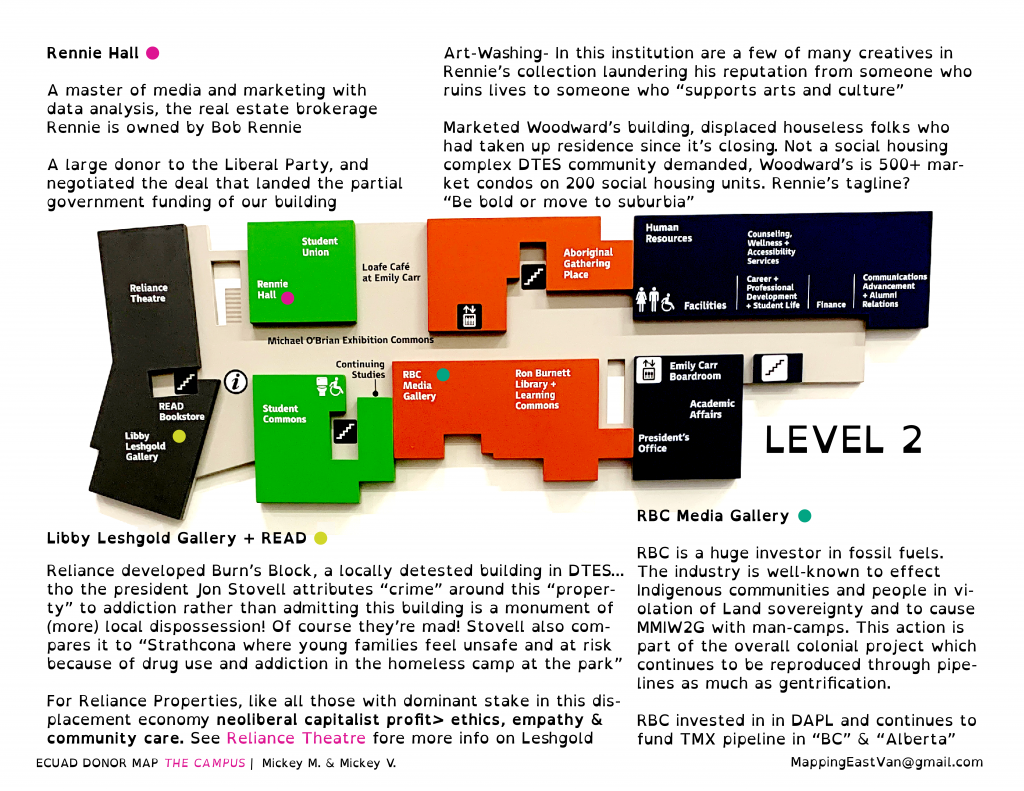
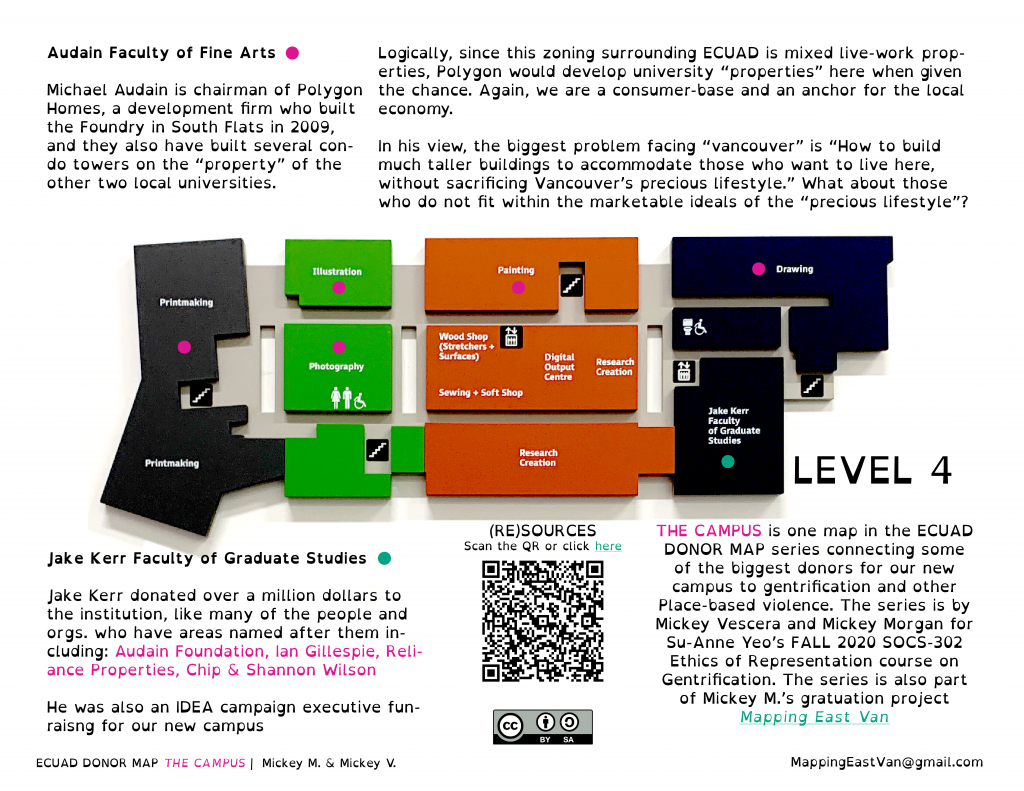
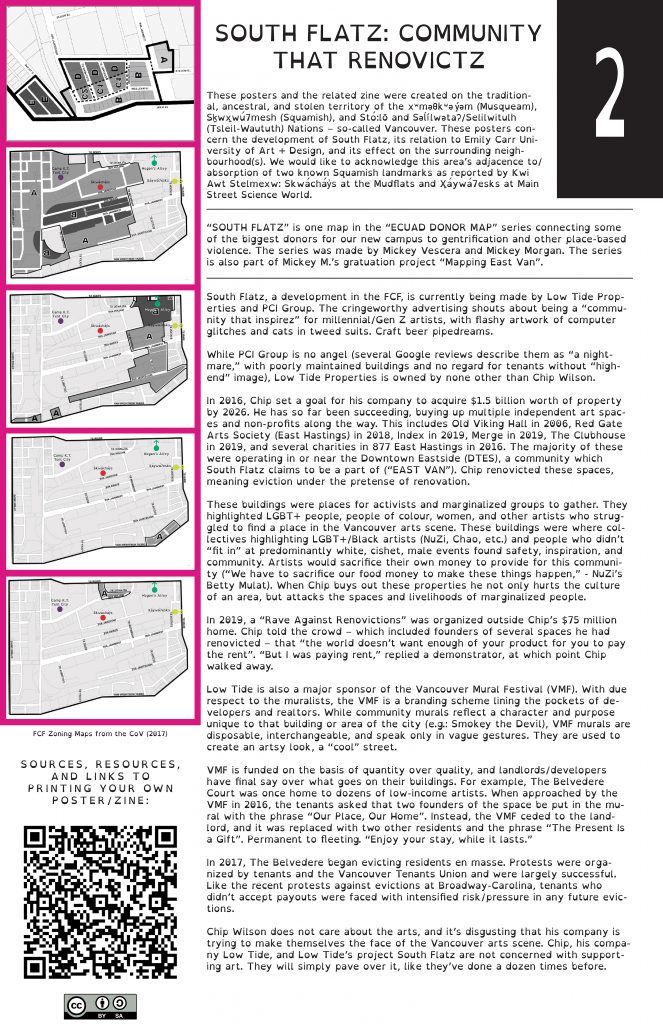
The ECUAD DONOR MAP series is a zine and two posters connecting some of the biggest donors for our new campus to local gentrification and other Place-based violence. The series is by Mickey Vescera and Mickey Morgan for FALL 2020 SOCS-302 Ethics of Representation. The zine and poster is in the process of print distribution to named subjects and around East Van. In addition the series is also available for any and all to print and distribute (CC-BY-SA).
Some questions we contemplated in the construction of these maps, and throughout our scholarship at Emily Carr University of Art + Design:
How did we get here in this shiny new campus “owning” the Land? Who are our donors that paid for this? Where do we find them in our school and in our neighbourhoods? How much of the “property” in East Van do they own? What other capital investments do they hold? Who does our being here serve?
And ultimately, how can we disrupt this built-in power imbalance to be better neighbours?
Digital Format of the poster and zine are screenreader accessible.
Download links for the posters and zine:
POSTERS (DIGITAL FORMAT)
POSTERS (PRINTING FORMAT; PRINT ON 11×17” PAPER)
ZINE (DIGITAL FORMAT)
ZINE (PRINTING FORMAT; PRINT ON 8.5×11” PAPER)
Mutual Aid
As an actionable extension of this work, I acknowledge that by doing community-based art or creating in/of/inspired by a community I owe my neighbours. Beyond artists and learners, in being part of community, living, fighting playing, creating on stolen Land and Waters, we must combat the systems of colonial-capitalist violence beyond just thinking and talking about it– decolonizing, fighting oppression, acknowledging pluralistic understandings requires action. Praxis.
Fundamentally, cultural work and world-building and space-making/holding and helping your neighbours is creative praxis. Simultaneously while re-appropriating our extractive role as students/researchers/artists by bringing community work into the classroom, we also expand or perhaps decolonize by re-conceptualizing the container of a classroom as not a container at all but rather a place where you learn. A wonderful Nishnaabeg articulation of this is from Leanne Simpson in the text Land as Pedagogy.
Further updates and inspirations/references will be uploaded on an ongoing basis to the Mapping East Van website, including a Manifesto on Neighbourliness reporting what I’ve learned and critical discussions encountered on doing community work while “in but not of the University” (Moten and Harney The University: Last Words).
Open Source Map of East Van
Here’s the interactive map. Please add your stories of East Van into the map as you like, but do not delete contribution from others. It is open-source permission, so if you open the map in another tab you can add another place or add to the stories of a place already mapped.
The interactive map at the top of this page is built using google mymaps, an app of the multi-billion dollar corporation who is known for tracking and selling the data of its users. This map is also not very screenreader friendly, though there is some written text.
Though relatively user-friendly, it is also drawn in reflection of the inherent biases of colonial property and are labelled with the names that go along with it. In adding supplemental information/re-inscribing dis-placed people onto the Land, this open source map questions these constructs of race, property, time, capital, class and responsibility for our community by overlaying and emphasizing what is purposely left out.
View full credits for mapping.
Events
One public event per semester was organized for this project: ECUAD in East Van during Fall 2020 and ECU Campus in East Van: A Time for Story Sharing and Critical Discussion during Spring 2021 where we were collectively brainstorming ways to be neighbours.
At the end of the second event I put a call out for faculty to create a course on neighbourliness this summer that I would like to co-teach (image below), a practice of continuing my involvement in the community beyond my graduation. I’ve been grateful to get such a generous response from faculty, that this has been actualized through the course Practicing Neighbourly Responsibility co-taught with professors Laura Kozak and Jean Chisholm.
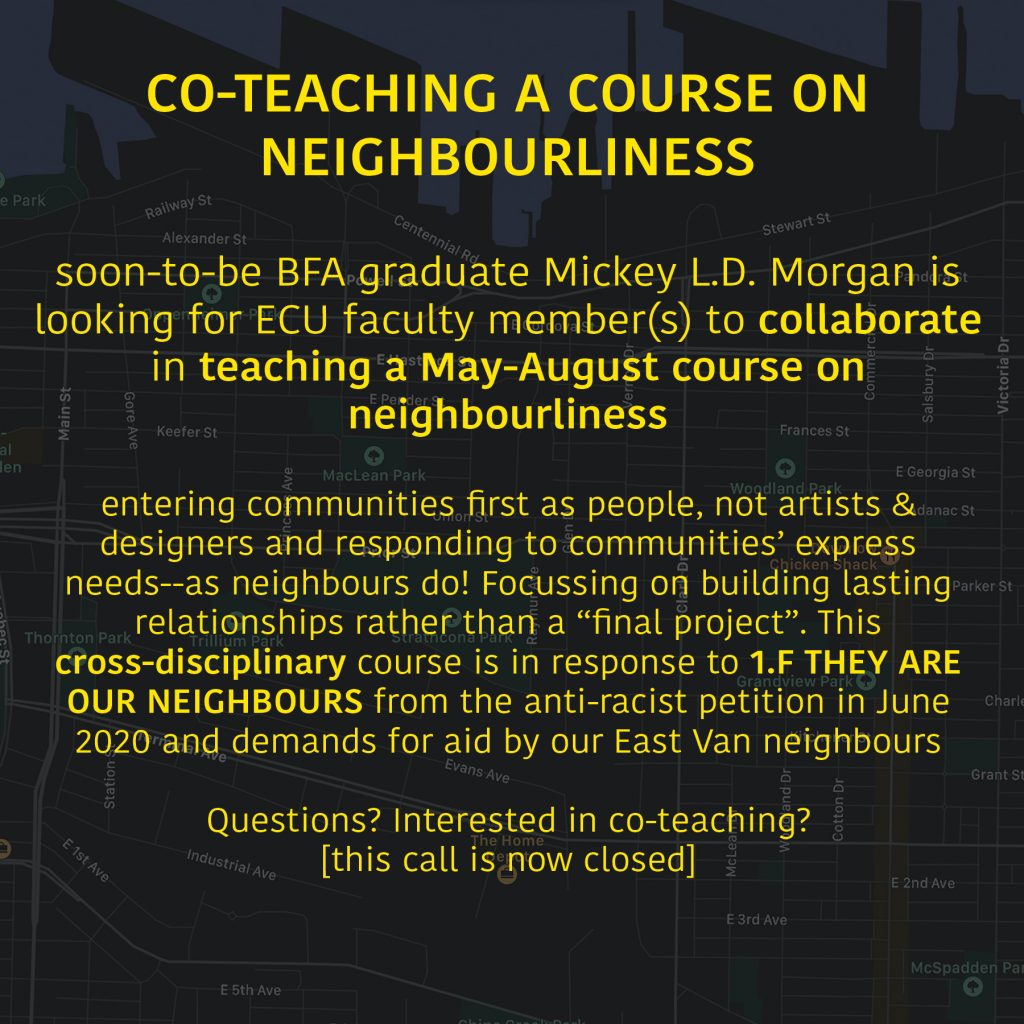
What is this?
Mapping East Van is cartography with the utmost subjectivity, composed of stories shared using various media, but primarily the thread is oral storytelling and community starting with a relational view from my personal positionality. “Vancouver” began as a colonial settlement for industrial logging, and some argue here is the orign of the term skid-rowe from the industry. Since then it has become a beacon of what it is to be a Global City under neoliberal capitalism, seizing Land from, pricing out, and criminalizing those who cannot/will not produce wealth for this system. Due to ECUAD’s location in the top-down parasitic displacement-project that is gentrification, with our new campus and as participants in neoliberal capitalism we are (often simultaneously) complicit in and targets of this slow and insidious violence. Capitalism necessitates individualism, erasure of competing narratives, and physical dis-placement. So, my methodology is acknowledging stories of place as collective, formed together, and rejecting further capital constructs of space, time, and status. This matrixed mapping is with the ultimate goal to encourage the idea of neighbourly-ness (1.F) that entails not only basic kindness and respect but also mutual accountability, strengthened relations, and points for resistance and solidarity to flourish.
This mapping matrix has begun as the graduation project of me, Mickey, in finishing an Undergraduate Degree of Fine Arts with a major of Visual Arts and minor of Social Practice and Community Engagement at Emily Carr University whose campus moved into East Van during my foundation year in 2017.
Portions of Mapping East Van has been created in my capacity as a Programming Research Assistant in the ECUAD fall series Digital and Creative Knowledge Sharing. Specifically I responded to research-creation methods of mapping and storytelling explored in a talk by Dorit Naaman.

